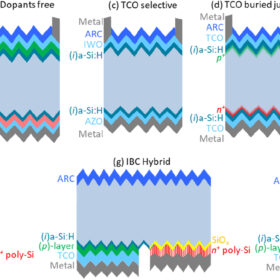Spanish company unveils PV-driven thermal system for self-consumption
Spain’s H2 Fusión says its Solar Heat PR5 system uses PV energy to produce hot water for self-consumption in industrial buildings, reaching temperatures of up to 92 C.
Colored modules for building-integrated photovoltaics
Taking inspiration from the 3D photonic structures on a Morpho butterfly’s shimmering blue wings, scientists at Germany’s Fraunhofer Institute for Solar Energy Systems ISE have developed colored solar panels that can be incorporated into a building’s exterior practically invisibly while maintaining high efficiency.
New method to predict solar module lifespans under sand erosion
A team of researchers in Algeria has designed a new testbed and a novel acceleration law that accounts for both wind speed and sand density. The new methodology was tested on four PV modules and showed lifespans of up to 47 years in terms of sand impact.
TU Delft research suggests back contact tech may push crystalline silicon PV over 28% threshold
Researchers in the Netherlands have investigated how carrier-selective contacts may help achieve stronger performance in back-contact (BC) crystalline silicon solar cells and have predicted efficiencies may reach up to 28.64%. Their analysis considered work function, energy barriers, and energy alignment across the stack of layers.
Solar module downward price trend has been reversed
High-efficiency solar modules are becoming scarce, prompting some retailers to stockpile in anticipation of rising prices, says Martin Schachinger, founder of pvXchange.com. He expects module prices to climb moderately but steadily until at least early next quarter.
Driver charged over fatal road incident involving solar panel
A Sydney man has been charged after a solar panel allegedly “dislodged” from a portable power station he was towing, flew through the windshield of another car and struck and killed its driver.
Polyshine Solar unveils ultralight, flexible rooftop solar panels
The Chinese manufacturer said its new flexible modules have an efficiency of up to 20.1% and a weight of only 7.5 kg, or 2.92 kg/m2. The new products have purportedly a light transmittance of over 91% and “ultra-high” UV blocking ability.
Chinese PV Industry Brief: China General Nuclear concludes 10 GW mounting system tender
The selected bidders are Trina Solar, Antai Ke Clean Energy, Xin Yuan Electric, Guoqiang Xing Sheng Energy Technology, and TBEA, with the winning bid prices ranging from CNY 0.209 ($0.29)/W to CNY 0.221/W.
Austrian startup presents vertical bifacial PV systems for garden fences
Sunbooster GmbH is offering 372 W flexible solar systems including inverters and cabling. The price for the smallest version is €500 ($524).
Polysilicon market holds steady, awaiting policy-driven shift
In a new weekly update for pv magazine, OPIS, a Dow Jones company, provides a quick look at the main price trends in the global PV industry.









